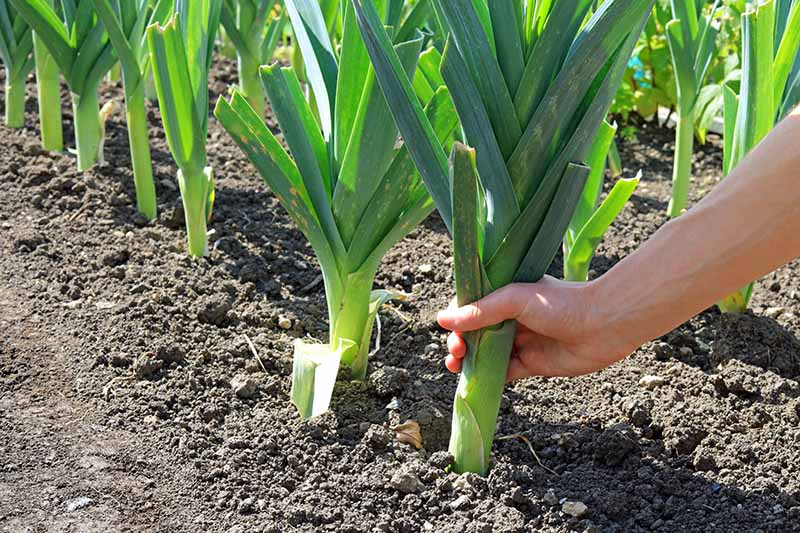Table of Contents
Having a kitchen garden is bliss. Imagine harvesting everything from your yard. Isn’t it great? If you too love to plant herbs, then you can start with growing leeks. This leafy herb has the flavour of onion and finds use in several dishes.
These herbs are loaded with vitamins A, C, and folate. Besides, the kaempferol present in leeks is considered to be an effective phytochemical against cancer. Hence, consuming leeks not only bring flavour to your dish but also boosts your health.
Besides its versatile usage, this herb is easy to grow. However, knowing the right way of growing and harvesting can make things easier. So, if you have been wondering, “ How and when to harvest leeks?”
Then, in this blog, we will cover all the aspects associated with growing and harvesting leeks.
Understanding Leeks
Before you go ahead and start the plantation process, let us have a quick overview of this magical herb. Leek belongs to the Amaryllidaceae family and is known by the scientific name: Allium ampeloprasum var. porrum. These are sometimes also referred to as long onions. Anatomically, you will find leeks to be densely packed at the base (white in colour), and the leaves fan out at the top, somewhat similar to a spring onion. The taste of Leeks is similar to that of onion.
Coming to its growth, then leeks are easy to grow. And the best part is that it can be easily cultured indoors. So, even if you have a small garden, leeks can be your friendly herb. Coming to its harvesting part, then Leeks can be harvested as per your choice. You can enjoy tender baby leeks for grilling or roasting. Also, if you want to prepare soup or casseroles, then mature leeks are a good choice.
How to Harvest Leeks
1. Choosing The Right Variety
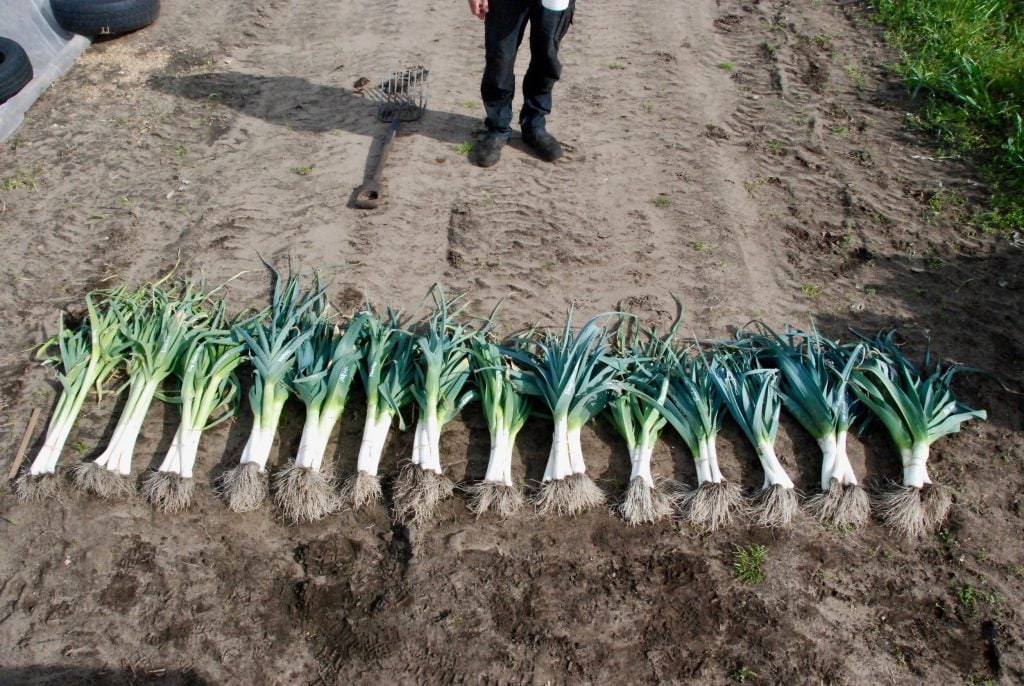
The first step is to choose the right variety of leek. In the market, you will find several options, like the leeks variety based on the season. It includes examples like winter leeks, summer leeks, and others. Similarly, there are other variants like disease-resistant variants or hardiness.
Irrespective of the variant you choose, to ensure good and healthy growth of leeks, it is important to invest in good quality leek seeds or cultivars. You can easily buy quality leek seeds online or from a nearby nursery.
Tabular Representation of the Different Varieties of Leeks and Timeline for Harvesting
|
Variety of Leeks |
When to Harvest (Number of Days) |
|
Bandit |
120 |
|
Chinook |
65 |
|
Comanche |
105 |
|
Giant Musselburgh |
100 |
|
Large American Flag |
120 |
|
Lancia |
90 |
|
Lancelot |
100 |
|
Megaton |
105 |
|
Tadorna |
100 |
|
Varna |
70-80 |
2. Prepping Up the Garden
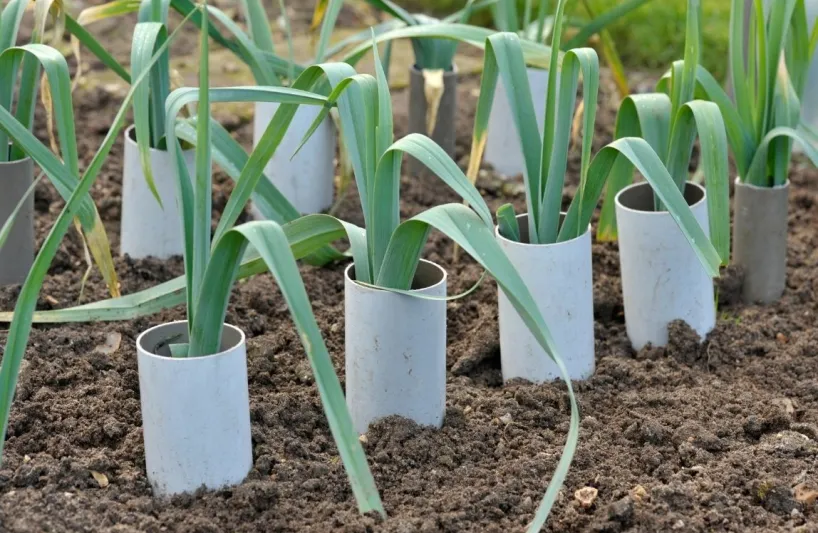
Once you have got the best variant of leek seeds, now is the time to get the ground or seedbed ready for actual work. You can start sowing leeks during the spring. Once it starts showing the sign of growth, it is ready to be shifted to the main site. This process is called transplanting (discussed later). These are directly planted on the ground and in a straight line. Make sure that there is a distance of at least 6 inches between each leek plant. It ensures that the leeks get sufficient space to grow.
Points to Note
|
Sowing Season |
Spring |
|
Soil |
Non-acidic soil |
|
Water requirement |
Moist soil but no over-drained |
|
Fertilization |
Add compost for a bountiful growth |
|
Sunlight |
Exposure to sunlight promotes growth |
3. Time to Sow
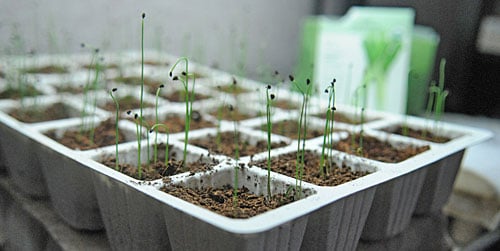
Although leeks grow well outdoors, with the right amount of fertilizer, you can also cultivate them indoors. The following segments throw light on the same:
|
Sowing Leeks Outdoor |
Sowing Leeks Indoors |
|
The month of March and April are perfect, to begin with the planation of leeks. You can sow them in the seedbed or directly on the ground. |
For the early harvest of the indoor leeks, you can start the plantation during the winters when the temperature is at least 7°C (45°F). |
|
Prepare the ground by digging a hole of about 1cm (¾in) deep. Add water to it. |
Add compost to the pots, sprinkle water, followed by adding seeds 1cm (¾in) deep. |
|
Start sowing the seeds. Make sure that they are planted in a straight line at a distance of at least 6 inches distance. |
Make sure that the seed is in warm conditions and receives sunlight. Also, if you see roots growth, shift it to a bigger pot. |
|
Cover it with a cloche or fleece. |
Don’t miss to water it, but don’t overdo it. |
|
After 2 months, when you see the plant to be at least 20 cm in height. It is ready to be transplanted to the main site. |
Within 8 weeks, it reaches a height of 20 cm; it is ready to be transplanted outdoors. |
4. Transplanting It to The Outdoors
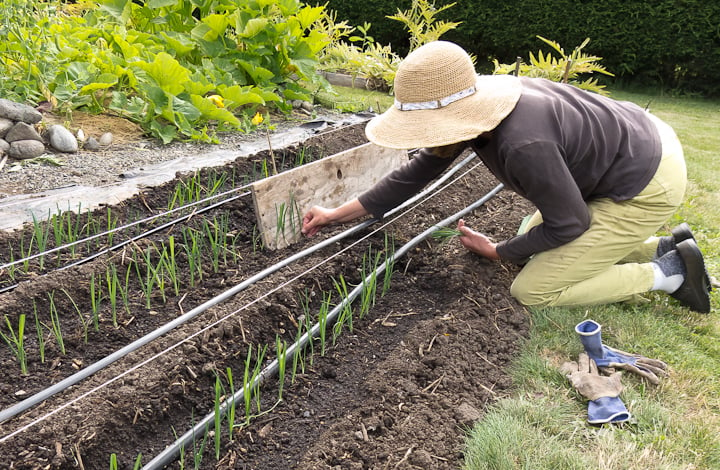
Once the seedbed is ready with plants (20 cm), it is ready to be transplanted outdoors. However, if you have raised the seeds indoors, it needs to be acclimatized before shifting them outdoors.
- Before transplanting, make holes in the ground. Here you will be doing deep planting, so the hole should be at least 15cm (6in) deep and 5cm (2in) across.
- The holes should be at a distance of at least 6 inches. This distance depends on the variety of leeks. For example, if you are growing baby leeks, then a distance of 4 inches is enough.
- Once the hole is dug, carefully lift each leek from the seedbed flowed by trimming the roots and planting it.
- Cover the roots with soil and water it till the time soil settles.
5. Plant Care Tips
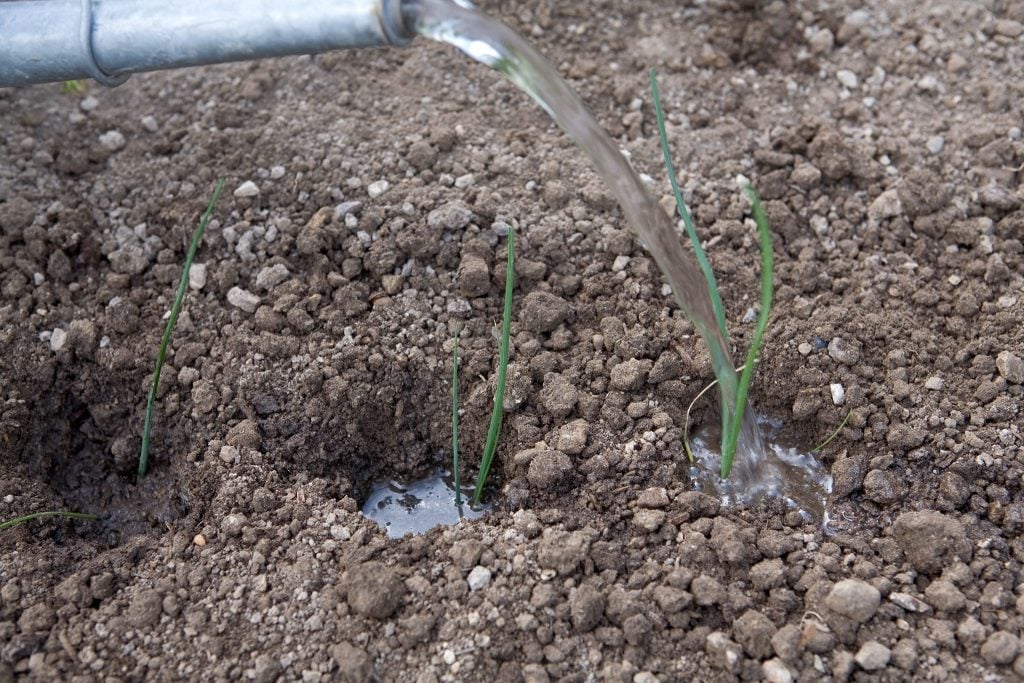
Below are some of the caring tips for leeks listed:
- Regularly water the leeks but don’t overdo them.
- Remove the weed
- Add compost
- Add a layer of mulch to lock the moisture
When to Harvest Leeks
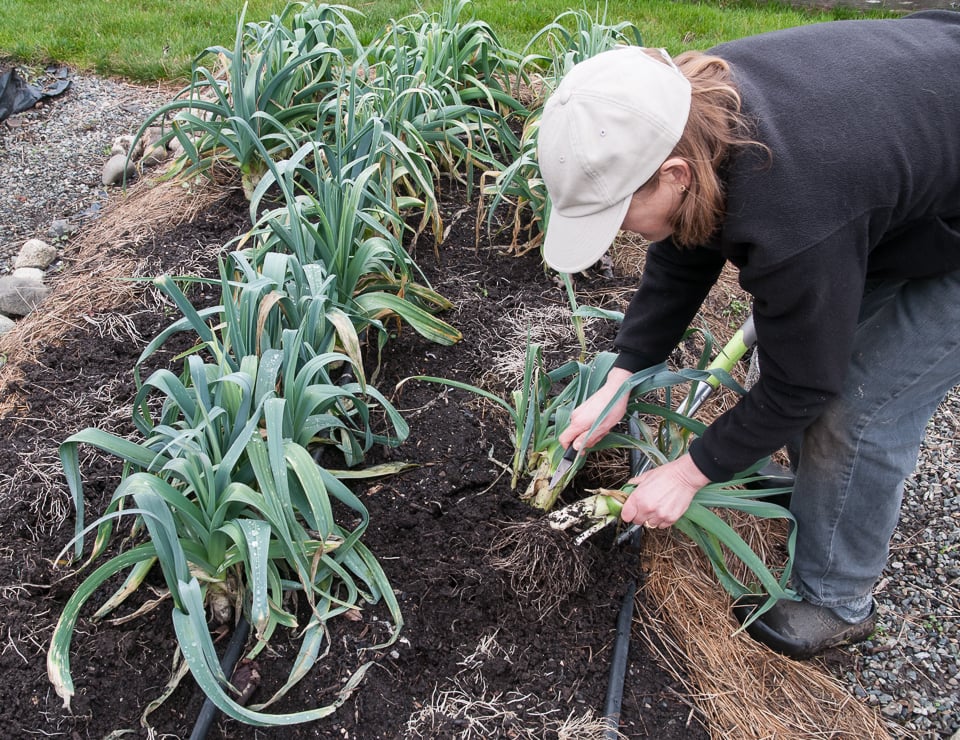
One of the best features of leeks is that they can be harvested as per your preference. Once you see the shoot sprouting from the ground, you can harvest it when it’s tender or leave it for a few weeks for it to mature.
Here are some of the key things to know before you go ahead to harvest leeks:
- When the shaft is 3 inches (7 cm) long or more, leeks are ready for harvest.
- Make sure that you keep a check on the base of the leeks. Don’t let it overgrow to form a bulb.
- The top end of the leek is called the flag. When it is dark blue-green in colour, it is ready to harvest.
- Leeks are ready to be harvested from later summer to early spring.
- The non-hardy variant of leeks is ready for harvest within 60-90 days but has a milder flavour.
Summary of Growing Leeks
- Planting the leeks when the weather is cool or planting it early spring and fall.
- Grow it initially on raised beds or in-ground gardeners.
- These can be easily grown in containers and pots.
- Give ample space of 6 inches between two cultivars.
- Exposure to sunlight for at least 6 hours is recommended.
- Make sure that the soil is well-drained.
- Adding compost ensures healthy and nutrient-rich growth
- Do not over-water Leeks, as it may impact the growth
- Once you notice leeks growing, you can harvest them at any time based on your diet and consumption pattern.
Different Types of Leeks
When you start exploring the market, you will find a host of leek verities. There are hybrid seeds and open-pollinated varieties. Based on your preference, you can pick the best option. Additionally, leeks are also categorized based on the maturity season. Here is the list of them:
- Summer leeks
- Autumn leeks
- Autumn-Winter leeks
- Winter leeks
Nutritional Benefits of Leeks
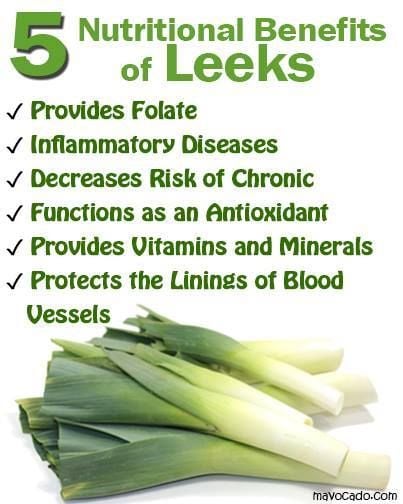
Leeks are not only a bundle of flavour but also offer several health benefits. Here are some of them:
- Leeks are enriched with Vitamin A and C, Manganese, Copper, Iron and Folate
- Vitamin K present in leeks helps in overcoming osteoporosis
- Studies have shown that consuming leeks can help in overcoming colorectal cancer
- The low-calorie count of Leeks makes them a good choice for weight management
- The lutein and zeaxanthin present in leeks helps in combating cataract and age-related eye issues
With all these benefits, leeks are certainly a wholesome herb. If you are also willing to reap the benefits of home-grown herbs, then read ahead.
Wrapping It Up
All in all, leeks are easy to grow. However, you need to ensure timely care. Missing out on basics like watering the plant and the right time of sowing can impact the growth of leeks. At the same time, choosing the right variety of leeks is also important. It also defines the kind of yield you would get. Besides, investing in good quality seeds is also significant. All this eventually impacts the growth of leeks.
Leeks are trouble-free plants; you don’t need to invest much in their maintenance. However, they are prone to fungal infection, especially because of damp conditions.
So, make sure that you don’t overwater the plant. With these simple tips, you can ensure the healthy growth of leeks.
Frequently Asked Questions
Can I Grow Leeks Indoors in Pots?
Most gardeners have this question. Leeks are an easy herb to grow. You can easily grow them indoors by providing the right growth conditions. Make sure that you expose them to sunlight and also provide liquid plant food for good growth.
How Do I Know Leeks Are Ready to Harvest?
Leeks can be harvested when they are tender and till the time they mature. Here are certain signs that indicate that leeks are ready to harvest:
- Leaves are blue-green in colour. The light green colour means it is still at a growing stage.
- Check the white stalk. It should be around 3 inches wide.
- The diameter of the stalk should be 1 inch. Although you can allow the leaf to grow beyond this, if you prefer tender leeks, then 1 inch-diameter leek is good to harvest.
Which Season Is Best to Sow Leeks?
You can start planting leeks between spring and early summer. If you plant them indoors, expose them to sunlight and water them aptly to get their optimum growth. It’s best to grow the leeks in the above-mentioned season to get the desired results.

